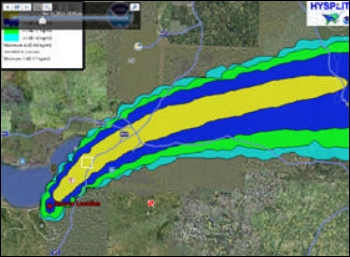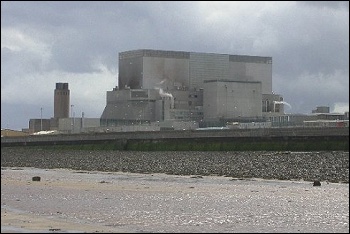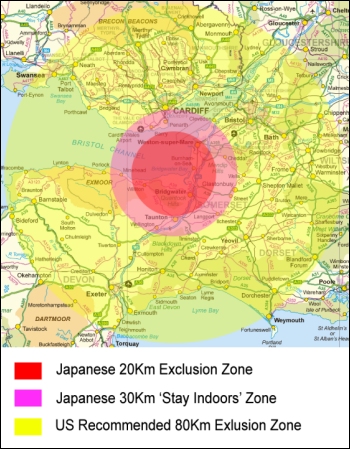Anti-nuclear campaigners have this week released details of a new study showing the effects of a huge tsunami hitting Hinkley Point power station.
The Stop Hinkley group says the new analysis has been prompted by the seriousness of the radiation releases into the environment after Japan’s Fukushima nuclear accident in March.
The new research paper by Professor Chris Busby, Dai Williams and Cecily Collingridge from The Green Audit asks “What would have happened to the fallout if a tsunami damaged Hinkley Point on 11th March 2011?”
It includes an animation, pictured below, tracking the path of a plume following a six hour release of radiation.
The two-page study concludes: “What is clear from these calculations is that radioactivity at the levels being released from Fukushima would contaminate the Home Counties and London and would rapidly make the south of England uninhabitable.”
Stop Hinkley’s Crispin Aubrey told Burnham-On-Sea.com: “The sobering simulation brings home the fact that although the Hinkley site may seem remote from large and growing population centres, the nature of weather patterns would ensure that millions would be exposed to the plume.”
 He added: “Whilst the prospect of a tsunami in Somerset may seem remote, that cannot be said of coolant losses, which are worryingly commonplace.”
He added: “Whilst the prospect of a tsunami in Somerset may seem remote, that cannot be said of coolant losses, which are worryingly commonplace.”
“At Hinkley Point B there have been a total of six such incidents since 2005, one of which was a direct leak from Reactor No.4, and a total of 47 coolant loss incidents across the UK.”
Cecily Collingridge, one of the new report’s authors, added: “There are serious doubts as to whether the government’s safety review goes far enough in making sure we avoid the type of disaster envisaged in this scenario. We really need to appreciate what we might be letting ourselves in for.”
An EDF Energy spokesman told Burnham-On-Sea.com it would not be issuing a response to such a “hypothetical” report.
EDF has previously said it is committed to implementing the recommendations of the government’s Weightman Report on the safety of UK nuclear plants.
EDF welcomed the interim report from Dr Mike Weightman into the implications of events at Fukushima, adding that it welcomed the interim conclusions that the UK nuclear power industry has reacted “responsibly and appropriately” to events in Japan, “displaying a leadership for safety and a strong safety culture”.
 EDF Chief Executive Vincent de Rivaz also welcomed the Secretary of State Chris Huhne’s assessment that the report reassured the Government that new nuclear can be part of the future energy mix.
EDF Chief Executive Vincent de Rivaz also welcomed the Secretary of State Chris Huhne’s assessment that the report reassured the Government that new nuclear can be part of the future energy mix.
Mr de Rivaz added: “Within days of the tsunami we undertook our own internal review of the implications of Fukushima. We took immediate actions to check our back up systems, organise refresher training for employees and review our Emergency Plan. We also began our longer term planning and put in place formal arrangements to ensure that any learnings from Japan are fed into our safety processes. As a result, we are in a position to begin implementing Dr Weightman’s recommendations today.”
“Continuous improvement is part of the safety culture of EDF Energy. We invest on average over £300 million each year in our plants to ensure they remain at the forefront of nuclear safety. This same principle means that lessons from Japan will further enhance safety.”







